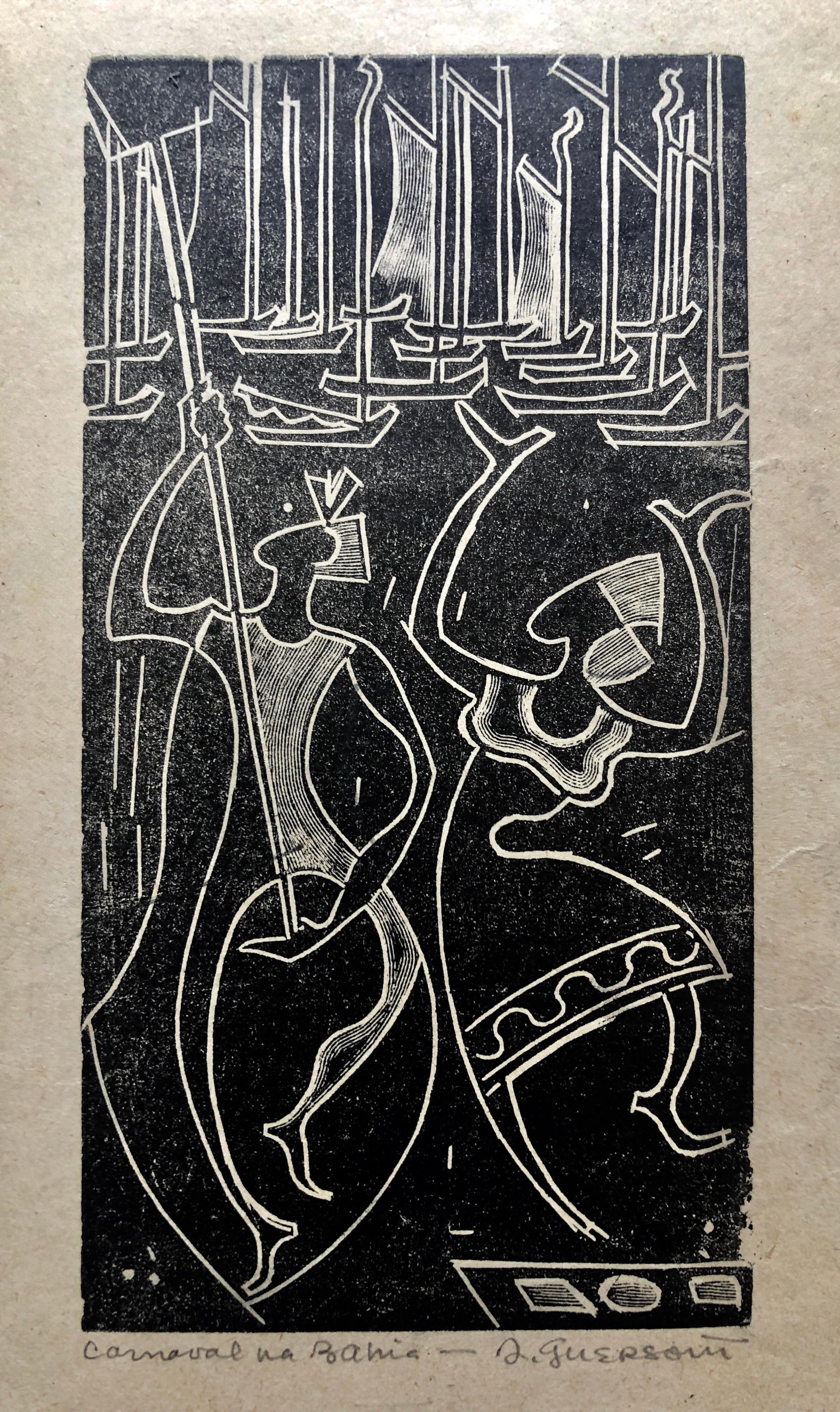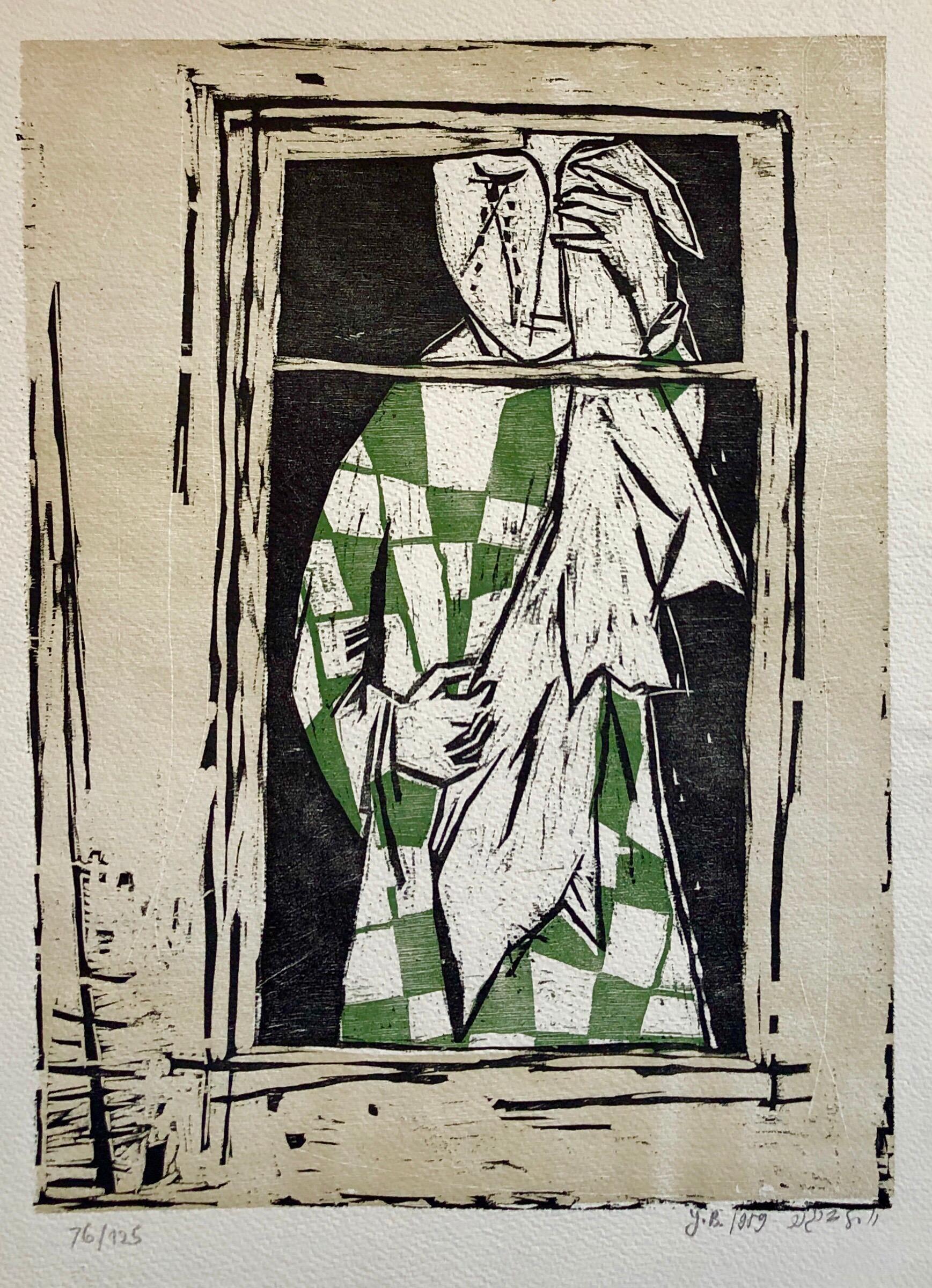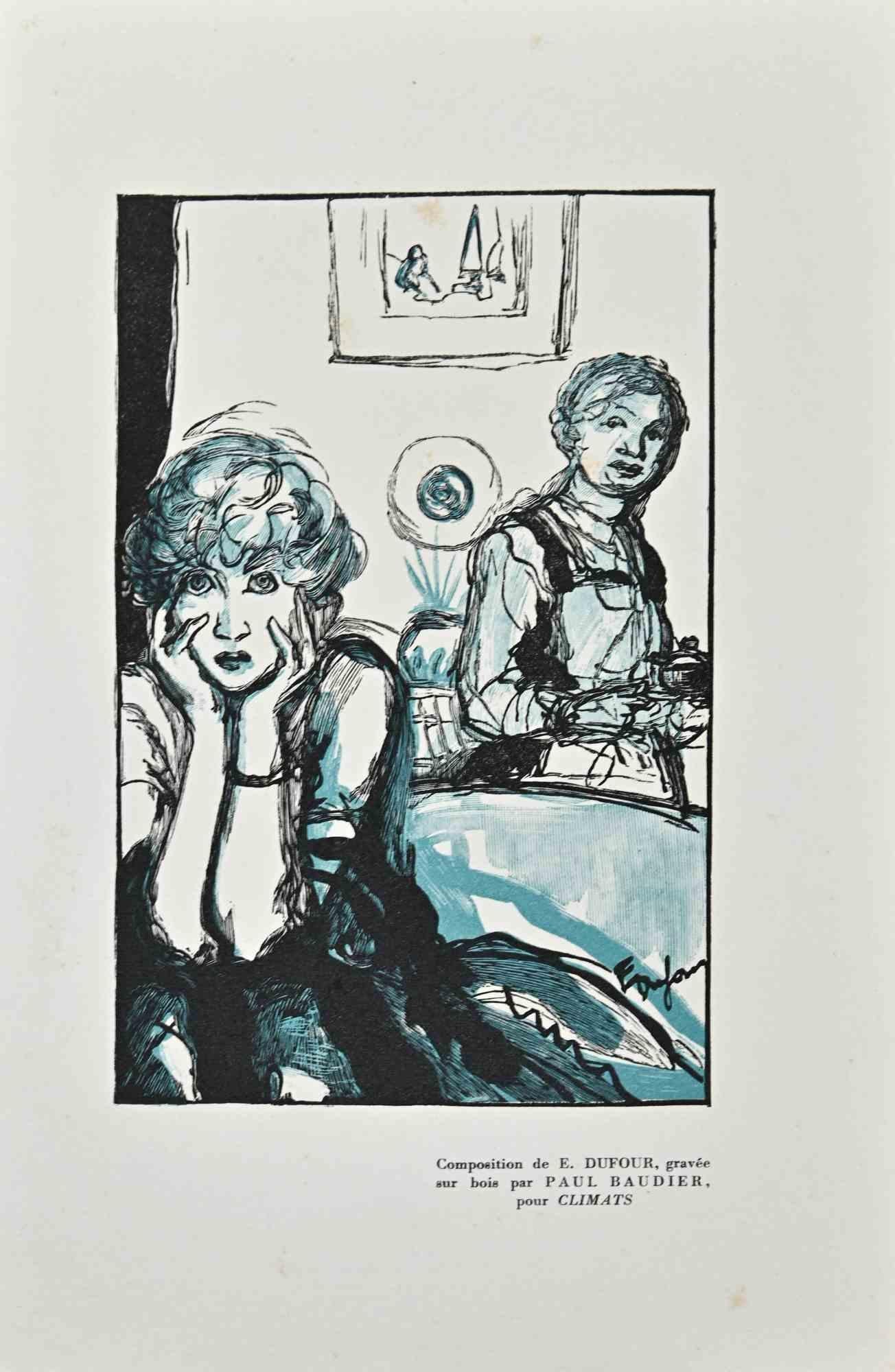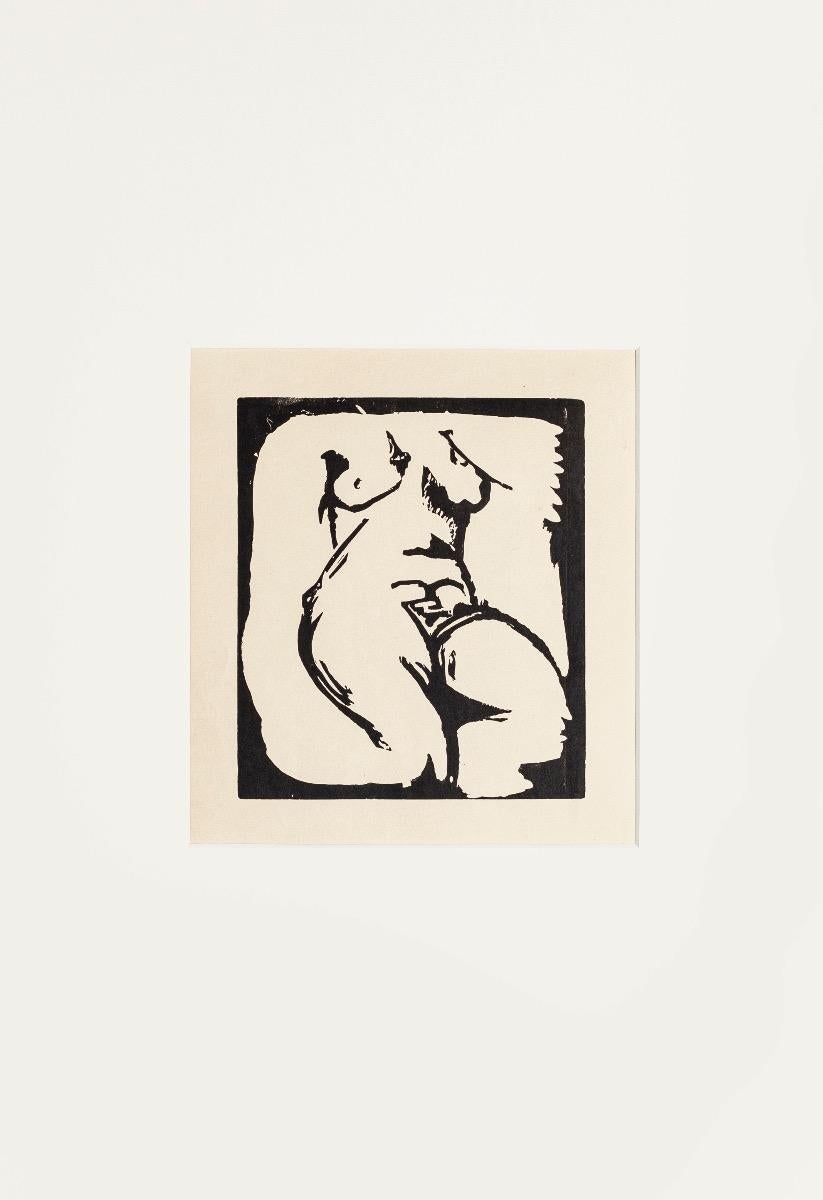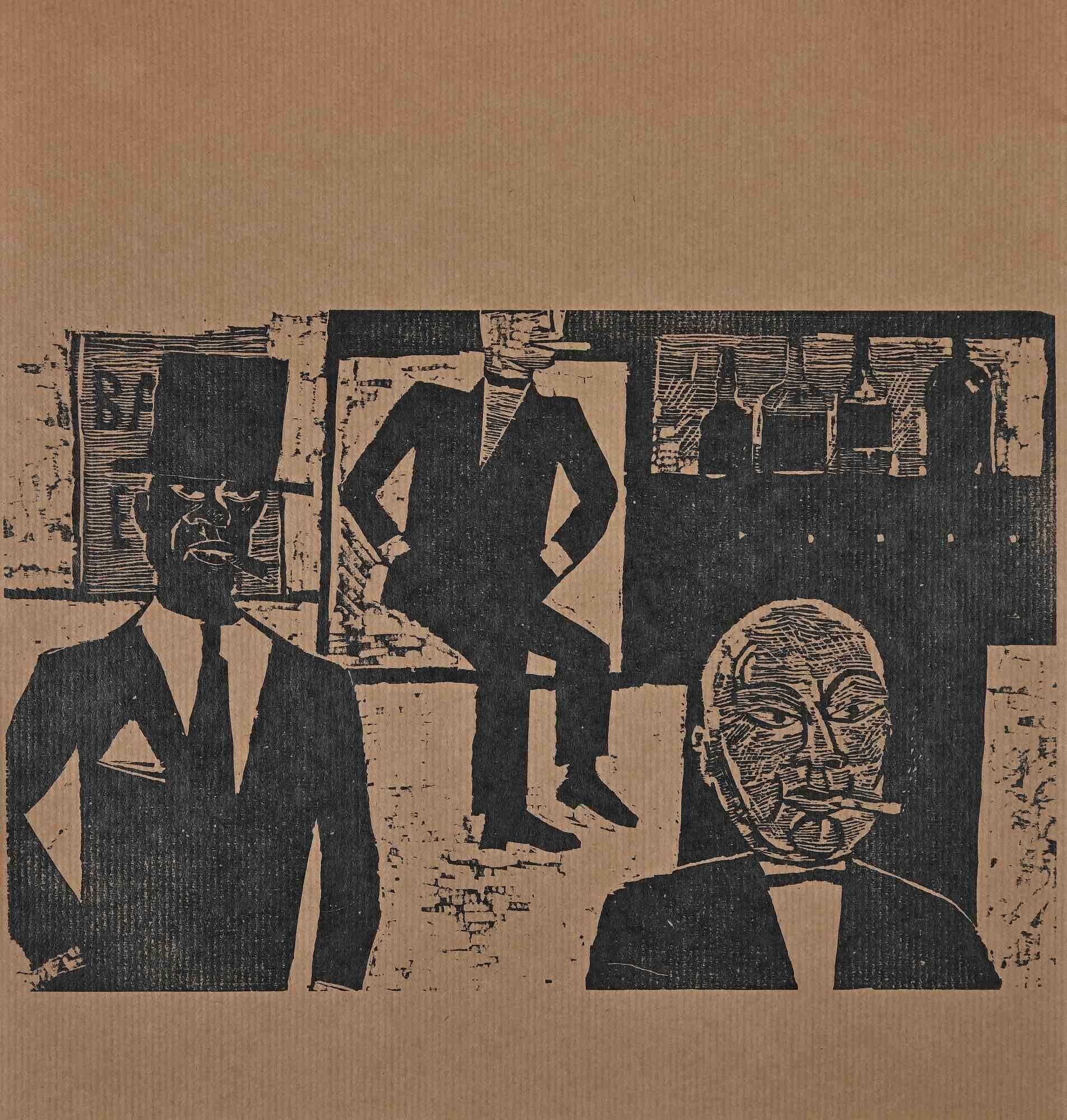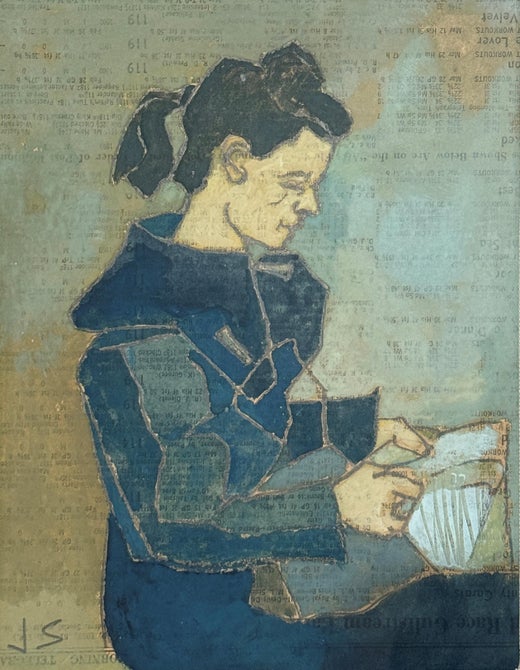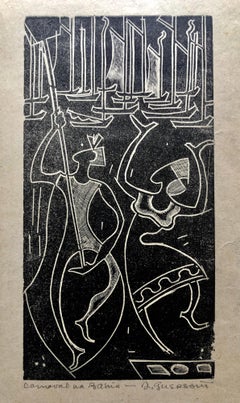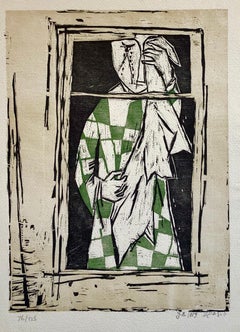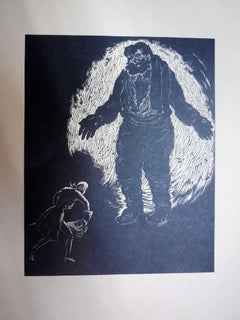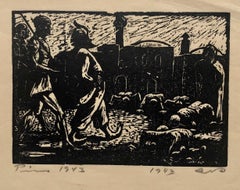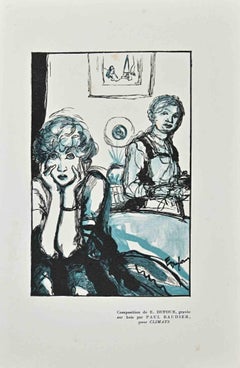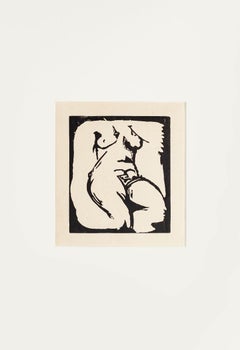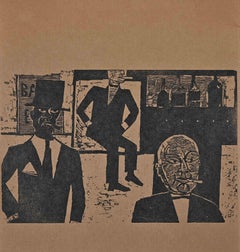Items Similar to 1936 Woodblock Print Venus of 23rd St. Skid Row Woodcut NYC Great Depression WPA
Want more images or videos?
Request additional images or videos from the seller
1 of 7
Joseph Solman1936 Woodblock Print Venus of 23rd St. Skid Row Woodcut NYC Great Depression WPA1936
1936
$1,600
£1,207.48
€1,382.38
CA$2,256.53
A$2,477.39
CHF 1,292.46
MX$29,979.86
NOK 16,198.97
SEK 15,263.69
DKK 10,319.08
About the Item
A great New york City street scene in a modernist realist style. done in the the great depression period.
Mat is 17.5x14, sheet measures 13x10 image is 10x4.75
Joseph Solman (January 25, 1909 – April 16, 2008) was a Jewish American painter, a founder of The Ten, a group of New York City Expressionist painters in the 1930s. His best known works include his "Subway Gouaches" depicting travellers on the New York City Subway.
Born in Vitebsk, Belarus, Russian Empire, he was brought to America from the Russian Empire as a child in 1912, Solman was a prodigious draftsman and knew, in his earliest teens, that he would be an artist. He went straight from high school to the National Academy of Design, though he says he learned more by sketching in the subway on the way back from school late at night: people "pose perfectly when they're asleep." In 1929, Solman saw the inaugural show at the Museum of Modern Art featuring Seurat, Gauguin, Van Gogh, and Cézanne.
In 1934, Solman had his first one-man show, much influenced by the French modern artist Georges Rouault. One critic was impressed by "the mystery that lurks in deserted streets in the late twilight." Another noted that Solman's color had "an astonishingly rich quality that burns outward beneath the surface."
Joseph Solman was, with Mark Rothko, the unofficial co-leader of The Ten, a group of expressionist painters including Louis Schanker, Adolph Gottlieb, Ben Zion and Ilya Bolotowsky, who exhibited as the "Whitney Dissenters" at the Mercury Galleries in New York City in 1938. The members, all immigrant Jewish New Yorkers with an interest in European Expressionism, presented an urban, abstract, formal style. A champion of modernism, Solman was elected an editor of Art Front Magazine when its other editors, art historian Meyer Schapiro and critic Harold Rosenberg, were still partial to Social Realism. But Solman never believed in abstraction for abstraction's sake. "I have long discovered for myself," Solman has said, "that what we call the subject yields more pattern, more poetry, more drama, greater abstract design and tension than any shapes we may invent." As his colleagues in the Ten advanced toward a more non-objective art, Solman warmed toward representation. An artist in the Works Project Administration (WPA) during the depression, Solman met and worked with and befriended many great artists, like Milton Avery. “Avery had a big influence on me when I was young and working in the WPA,” said Solman. “That was a great program, I couldn’t have worked without it. It’s where I saw Paul Klee’s work, which I liked very much.” By the early 1950s, when the Abstract Expressionism he had helped to develop was the mainstream in avant garde art, he was done with it. With Edward Hopper and Jack Levine, he began a magazine called "Reality." It featured the work of figurative painters, then terribly out of fashion, but its central editorial stance was that artists should be able to paint however and whatever they liked. In writing about a purchase of a typical 1930s Solman street scene for the Wichita Museum, director Howard Wooden put it this way: "Solman has produced the equivalent of an abstract expressionist painting a full decade before the abstract expressionist movement came to dominate the American art scene, but without abandoning identifiable forms."
In 1964, The Times, discussing his well-known subway gouaches (done while commuting to his some-time job as a racetrack pari-mutuel clerk), called him a "Pari-Mutuel Picasso." In 1985, on the occasion of a 50-year retrospective, The Washington Post wrote: "It appears to have dawned, at last, on many collectors that this is art that has already stood the acid test of time.
- Creator:Joseph Solman (1909-2008, American)
- Creation Year:1936
- Dimensions:Height: 17.5 in (44.45 cm)Width: 14 in (35.56 cm)
- Medium:
- Movement & Style:
- Period:
- Condition:good. measurements include mat, mat with minor wear. minor wrinkling.
- Gallery Location:Surfside, FL
- Reference Number:1stDibs: LU38213822742
Joseph Solman
Brought to America from Russia as a child in 1912, Joseph Solman was a prodigious draftsman and knew, in his earliest teens, that he would be an artist. He went straight from high school to the National Academy of Design, though he says he learned more by sketching in the subway on the way back from school late at night: people “pose perfectly when they’re asleep.” In 1929, Solman saw the inaugural show at the Museum of Modern Art featuring Seurat, Gauguin, Van Gogh, and Cezanne. It changed his life – and his art. Joseph Solman was, with Mark Rothko, the unofficial co-leader of The Ten, a group of expressionist painters who exhibited as the “Whitney Dissenters” at the Mercury Galleries in New York in 1938. A champion of modernism, Solman was elected an editor of Art Front Magazine when its other editors, art historian Meyer Shapiro and critic Harold Rosenberg, were still partial to Social Realism In 1964, The Times, discussing his well-known subway gouaches (done while commuting to his some-time job as a racetrack pari-mutuel clerk), called him a “Pari-Mutuel Picasso.” In 1985, on the occasion of a 50-year retrospective, The Washington Post wrote: “It appears to have dawned, at last, on many collectors that this is art that has already stood the acid test of time.” We had the pleasure of the meeting the artist a few times at his home which was over the original Second Avenue Deli in the East Village.
About the Seller
4.9
Platinum Seller
Premium sellers with a 4.7+ rating and 24-hour response times
Established in 1995
1stDibs seller since 2014
1,810 sales on 1stDibs
Typical response time: 1 hour
- ShippingRetrieving quote...Shipping from: Surfside, FL
- Return Policy
Authenticity Guarantee
In the unlikely event there’s an issue with an item’s authenticity, contact us within 1 year for a full refund. DetailsMoney-Back Guarantee
If your item is not as described, is damaged in transit, or does not arrive, contact us within 7 days for a full refund. Details24-Hour Cancellation
You have a 24-hour grace period in which to reconsider your purchase, with no questions asked.Vetted Professional Sellers
Our world-class sellers must adhere to strict standards for service and quality, maintaining the integrity of our listings.Price-Match Guarantee
If you find that a seller listed the same item for a lower price elsewhere, we’ll match it.Trusted Global Delivery
Our best-in-class carrier network provides specialized shipping options worldwide, including custom delivery.More From This Seller
View All1945 Brazilian Master, Art Deco Nudes Serigraph Woodcut Carnaval Bahia
By Odetto Guersoni
Located in Surfside, FL
Genre: Brazilian Art Deco, African Diaspora
Bahian Carnival
Subject: Abstract
Medium: Print
Surface: Paper
Country: Brazil
Dimensions of overall paper are listed.
This is from a series of work he did in the 1940's, we sold one called Ritmo Negro, they are about Afro-Brazilian jazz, dance and music.
Odetto Guersoni was born in the city of Jaboticabal, State of São Paulo, in 1924. From 1936 to 1941 he attended the Liceu de Artes de Ofícios in São Paulo, beginning his artistic career in 1945, when he exhibited paintings in the Hall of the Plastic Artists Union . Two years later he was part of the collective group of 19, alongside Aldemir, Charoux, Otavio Araújo, Grassmann, Maria Leontina and several other artists that time would make famous. He then practiced a figurative painting of accentuated Expressionist lauds, characterized by deformation and coloring, raw and Satirical- as, moreover, so many of his fellow exhibitors at the time. As a French government scholar, Odette Guerzoni went to Paris in 1947 and the following year took part in the Peintres et Graveurs Etrangers and Art Libre exhibitions. Student of engraving by Renê Cottet, gradually transformed this expressive medium into his favorite, to the detriment of painting, which he practically abandoned soon after.
In 1947, he participated in the 19 Painters exhibition at the Prestes Maia Gallery together with Lothar Charoux, Maria Leontina,Grassmann, Aldemir Martins, Luiz Sacilotto and hiró. Guersoni was awarded a scholarship by the French government, and traveled to Paris, where he began work in engraving. Back in Brazil, in 1951, he founded the Art Workshop, in São Paulo. In 1954, he returned to Europe for a year, financed by the International Labor Organization (ILO). In Geneva, he studied engraving with René Cottet (1902 - 1992) and worked in Stanley william Hayter's studio, Atelier 17, in Paris (1901 - 1988). From 1956 to 1957, he became director of the Union of Plastic Artists of São Paulo. From 1960, he attended, as a trainee, some art schools in the United States and Japan such as The New York School of Printing and Osaka University. In 1971, also in Japan, he attended the workshop of I. Jokuriti. Two years later, he was voted Best Recorder of the Year by the Paulista Association of Art Critics - APCA. He took part in a special room at the Ibero-American Biennial in Montevideo in 1983. The Pinacoteca do Estado de São Paulo - Pesp presents a retrospective of his work in 1994.
Odetto Guersoni explores the wide spectrum of possibilities of the engraving. In addition to using techniques such as metal etching, lithograph, serigraph, linocut and, especially, woodcut he developed, in the 1950s, the philigraphy, in which the forms he developed gained points of embroidery made by Bonadei (1906 - 1974) . And, in the 1960s, the plastigraphy, in which he makes engravings on pasty surfaces, obtained from gypsum or other soft material. In the 1970s, technical investigations were associated with pictographic, ideographic, archaic symbol searches, Brazilian cave paintings and plant forms. The drawings are reduced to stylized, geometric shapes and transformed into abstract graphic elements. The artist works with few matrices, which, organized in rectangles, squares or circles, become modules to be combined. Guersoni juxtaposes them, adds, changes colors, and thereby composes colorful mandalas and structural geometries. Based on concise compositions, it produces color vibrations through optical illusions. In many of his woodcut works of the 1980s he uses smooth wood, knives, saws, gouges, punches, avoiding the natural textures of wood. In printing, it leaves the vibrant color and employs dosed inks with colorless masses, obtaining transparencies by superpositions. New journeys of study and specialization in engraving techniques took him in 1954 to Switzerland, 1960 to the United States, and in 1966 to Germany and Austria. Today, after having performed more than 40 individuals including 16 abroad and having participated in more than 50 collectives in several countries, Guersoni is considered one of the most notable Brazilian engravers. Conquered awards in several shows.
CHRONOLOGY
Individual exhibitions
1946 - Sao Paulo SP - 10th Salon of the Artists' Union, at the Prestes Maia Gallery
1947 - São Paulo SP - 19 Painters, at the Prestes Maia Gallery
1948 - Paris France - Peintres et Graveurs Etrangers at the École des Beaux-Arts
1949 - São Paulo SP - 13th Salon of the Artists' Union, at the Prestes Maia Gallery
1951 - São Paulo SP - 1st Paulista Salon of Modern Art, at Prestes Maia Gallery - silver medal
1953 - São Paulo SP - 2nd International Biennial of São Paulo, at MAM / SP
1954 - São Paulo SP - 3rd Paulista Salon of Modern Art, in the Prestes Maia Gallery
1955 - Rio de Janeiro RJ - 4th National Salon of Modern Art
1955 - Salvador BA - 5th Baiano Salon of Fine Arts, in Belvedere da Sé - honorable mention
1962 - São Paulo SP - Leirner Prize for Contemporary Art at the Folha Art Gallery - 1st printing award
1963 - Curitiba PR - 20th Salão Paranaense de Belas Artes, at the Public Library of Paraná
1963 - Rio de Janeiro RJ - Individual, no MAM / RJ
1968 - Bradford England - First International Print Biennale
1970 - São Paulo SP - Antonio Henrique Amaral, Odetto Guersoni, Tomie Ohtake, Pedro Tort and Gerda Brentani, in the Alberto Bonfiglioli Gallery
1971 - São Paulo SP - 11th International Biennial of São Paulo, at the Biennial Foundation - acquisition award
1973 - Punta del Este Uruguay - 1st Engraving Meeting of the Prata Basin Countries - International Prize
1977 - São Paulo SP - The Groups: the 40's, at the Lasar Segall Museum
1982 - São Paulo SP - Ismenia Coaracy, Odetto Guersoni and Alice Brill...
Category
1940s Art Deco Nude Prints
Materials
Woodcut
1959 Israeli Yosl Bergner Modernist Color Woodcut Woodblock Print
By Yosl Bergner
Located in Surfside, FL
Abstract Composition, 1959 Silkscreen Lithograph "Phoenix".
This was from a portfolio which included works by Yosl Bergner, Menashe Kadishman, Yosef Zaritsky, Aharon Kahana, Jacob Wexler...
Category
1950s Modern Figurative Prints
Materials
Lithograph, Screen
Shtetl Scene Expressionist woodcut
By Arthur Kolnik
Located in Surfside, FL
Arthur Kolnik was born in Stanislavov, a small town in Galicia, which was then part of the Austro-Hungarian Empire. His father, who was originally from Lithuania, worked as an accoun...
Category
1930s Expressionist Figurative Prints
Materials
Paper
1943 Israeli German Expressionist Woodcut Print Vintage Woodblock Bezalel School
By Jacob Pins
Located in Surfside, FL
Jacob Otto Pins (17 January 1917 – 4 December 2005) was a German-born Israeli woodcut artist and art collector, particularly of Japanese prints and paintings.
Jacob Pins was born in Höxter, Germany, the son of Dr Leo Pins, a veterinarian, and his wife Ida Lipper. He immigrated to Palestine in 1936 to study art. His father tried to discourage him from becoming an artist for financial reasons.
Pins' younger brother, Rudolph, (1920-2016) moved to the United States in 1934. His father was sent to Buchenwald. In July 1944, both parents died in the Riga ghetto.
Pins first lived on a kibbutz, which was disbanded in 1941. He moved to Jerusalem and studied woodcut and linocut under woodcut master and painter Jacob Steinhardt, also a German immigrant, at his small private school. He lived in poverty in a tiny room, subsisting on a meagre diet. He continued his studies at the new Bezalel Academy of Art and Design.
Pins was married to Elsa, the subject of a number of his prints. They had no children.
Pins bought his first Oriental print in 1945, and acquired a house on Ethiopia Street, opposite the Ethiopian church, where he lived for the rest of his life. He continued collecting until his death and was one of Israel's foremost art collectors. His book on Japanese Pillar Prints, Hashira-e is the definitive work on the subject.
Pins died in Jerusalem in December 2005.
Pins' artwork was heavily influenced by German expressionism and traditional Japanese wood block printing. From 1956 to 1977, he taught at Israel's leading art schools, most notably Bezalel, where he later became a professor. He was known as a demanding teacher, emphasizing strong technical skills and discipline.
In the 1950s, Pins helped to found the Jerusalem Artists' House, a centre for the city's artists to meet and exhibit.
Legacy
Pins' extensive collection of Japanese woodprints...
Category
1940s Expressionist Mixed Media
Materials
Woodcut
1945 Brazilian Master, Art Deco Clown Serigraph Woodcut
By Odetto Guersoni
Located in Surfside, FL
Genre: Brazilian Art Deco, African Diaspora
Bahian Carnival
Subject: harlequin clown
Medium: Print
Surface: Paper
Country: Brazil
Dimensions of overall paper are listed.
This is from a series of work he did in the 1940's, we sold one called Ritmo Negro, they are about Afro-Brazilian jazz, dance and music.
Odetto Guersoni was born in the city of Jaboticabal, State of São Paulo, in 1924. From 1936 to 1941 he attended the Liceu de Artes de Ofícios in São Paulo, beginning his artistic career in 1945, when he exhibited paintings in the Hall of the Plastic Artists Union . Two years later he was part of the collective group of 19, alongside Aldemir, Charoux, Otavio Araújo, Grassmann, Maria Leontina and several other artists that time would make famous. He then practiced a figurative painting of accentuated Expressionist lauds, characterized by deformation and coloring, raw and Satirical- as, moreover, so many of his fellow exhibitors at the time. As a French government scholar, Odette Guerzoni went to Paris in 1947 and the following year took part in the Peintres et Graveurs Etrangers and Art Libre exhibitions. Student of engraving by Renê Cottet, gradually transformed this expressive medium into his favorite, to the detriment of painting, which he practically abandoned soon after.
In 1947, he participated in the 19 Painters exhibition at the Prestes Maia Gallery together with Lothar Charoux, Maria Leontina,Grassmann, Aldemir Martins, Luiz Sacilotto and hiró. Guersoni was awarded a scholarship by the French government, and traveled to Paris, where he began work in engraving. Back in Brazil, in 1951, he founded the Art Workshop, in São Paulo. In 1954, he returned to Europe for a year, financed by the International Labor Organization (ILO). In Geneva, he studied engraving with René Cottet (1902 - 1992) and worked in Stanley william Hayter's studio, Atelier 17, in Paris (1901 - 1988). From 1956 to 1957, he became director of the Union of Plastic Artists of São Paulo. From 1960, he attended, as a trainee, some art schools in the United States and Japan such as The New York School of Printing and Osaka University. In 1971, also in Japan, he attended the workshop of I. Jokuriti. Two years later, he was voted Best Recorder of the Year by the Paulista Association of Art Critics - APCA. He took part in a special room at the Ibero-American Biennial in Montevideo in 1983. The Pinacoteca do Estado de São Paulo - Pesp presents a retrospective of his work in 1994.
Odetto Guersoni explores the wide spectrum of possibilities of the engraving. In addition to using techniques such as metal etching, lithograph, serigraph, linocut and, especially, woodcut he developed, in the 1950s, the philigraphy, in which the forms he developed gained points of embroidery made by Bonadei (1906 - 1974) . And, in the 1960s, the plastigraphy, in which he makes engravings on pasty surfaces, obtained from gypsum or other soft material. In the 1970s, technical investigations were associated with pictographic, ideographic, archaic symbol searches, Brazilian cave paintings and plant forms. The drawings are reduced to stylized, geometric shapes and transformed into abstract graphic elements. The artist works with few matrices, which, organized in rectangles, squares or circles, become modules to be combined. Guersoni juxtaposes them, adds, changes colors, and thereby composes colorful mandalas and structural geometries. Based on concise compositions, it produces color vibrations through optical illusions. In many of his woodcut works of the 1980s he uses smooth wood, knives, saws, gouges, punches, avoiding the natural textures of wood. In printing, it leaves the vibrant color and employs dosed inks with colorless masses, obtaining transparencies by superpositions. New journeys of study and specialization in engraving techniques took him in 1954 to Switzerland, 1960 to the United States, and in 1966 to Germany and Austria. Today, after having performed more than 40 individuals including 16 abroad and having participated in more than 50 collectives in several countries, Guersoni is considered one of the most notable Brazilian engravers. Conquered awards in several shows.
CHRONOLOGY
Individual exhibitions
1946 - Sao Paulo SP - 10th Salon of the Artists' Union, at the Prestes Maia Gallery
1947 - São Paulo SP - 19 Painters, at the Prestes Maia Gallery
1948 - Paris France - Peintres et Graveurs Etrangers at the École des Beaux-Arts
1949 - São Paulo SP - 13th Salon of the Artists' Union, at the Prestes Maia Gallery
1951 - São Paulo SP - 1st Paulista Salon of Modern Art, at Prestes Maia Gallery - silver medal
1953 - São Paulo SP - 2nd International Biennial of São Paulo, at MAM / SP
1954 - São Paulo SP - 3rd Paulista Salon of Modern Art, in the Prestes Maia Gallery
1955 - Rio de Janeiro RJ - 4th National Salon of Modern Art
1955 - Salvador BA - 5th Baiano Salon of Fine Arts, in Belvedere da Sé - honorable mention
1962 - São Paulo SP - Leirner Prize for Contemporary Art at the Folha Art Gallery - 1st printing award
1963 - Curitiba PR - 20th Salão Paranaense de Belas Artes, at the Public Library of Paraná
1963 - Rio de Janeiro RJ - Individual, no MAM / RJ
1968 - Bradford England - First International Print Biennale
1970 - São Paulo SP - Antonio Henrique Amaral, Odetto Guersoni, Tomie Ohtake, Pedro Tort and Gerda Brentani, in the Alberto Bonfiglioli Gallery
1971 - São Paulo SP - 11th International Biennial of São Paulo, at the Biennial Foundation - acquisition award
1973 - Punta del Este Uruguay - 1st Engraving Meeting of the Prata Basin Countries - International Prize
1977 - São Paulo SP - The Groups: the 40's, at the Lasar Segall Museum
1982 - São Paulo SP - Ismenia Coaracy, Odetto Guersoni and Alice Brill...
Category
1940s Art Deco Nude Prints
Materials
Woodcut
German Expressionist Woodcut Print Pencil Signed israeli Jerusalem Jacob Pins
By Jacob Pins
Located in Surfside, FL
Jacob Otto Pins (17 January 1917 – 4 December 2005) was a German-born Israeli woodcut artist and art collector, particularly of Japanese prints and paintings.
Jacob Pins was born in ...
Category
20th Century Expressionist Figurative Prints
Materials
Woodcut
You May Also Like
Ted Davies, El Station (New York City), woodcut
By Ted Davies
Located in New York, NY
In the 1950s woodcuts were getting bigger and bigger. This one isn't gigantic, but at an image size of 17 x 11 inches it is substantial. And of course NYC's El Trains and their stati...
Category
Mid-20th Century American Modern Figurative Prints
Materials
Woodcut
Womanly Preoccupation - Original Woodcut Print by Paul Baudier - 1930s
Located in Roma, IT
Womanly Preoccupation is an original woodcut print on ivory-colored paper realized by Paul Baudier (1881-1962) in the 1930s.
On the lower right description in French.
Very good con...
Category
1930s Modern Figurative Prints
Materials
Woodcut
Ricordi - Original Woodcut on Paper by Raymond Brudieux - 1940s
Located in Roma, IT
Figure of Woman is an original woodcut on paper realized by Anonymous Artist in 1940s.
Including a white cardboard passepartout (49 x 34 cm).
Not signed.
Good conditions.
Category
1940s Figurative Prints
Materials
Woodcut
Figures - Woodcut Print by Charles Sterns - Early 20th Century
Located in Roma, IT
Figures is a woodcut print on paper realized by an anonymous artist in the early 20th century.
Good conditions.
The artwork is depicted through soft strokes in a well-balanced comp...
Category
Early 20th Century Modern Figurative Prints
Materials
Woodcut
Pougny, Composition, Pougny, dix linogravures originales, 1914-1920 (after)
By Jean Pougny
Located in Southampton, NY
Linocut on vélin vergé ancien paper. Unsigned and unnumbered, as issued. Good condition. Notes: From the folio, Pougny, dix linogravures originales, 1964. Published by Au Vent d'Arle...
Category
1960s Cubist Abstract Prints
Materials
Linocut
$4,076 Sale Price
20% Off
Free Shipping
Figurative Woodblock by Herman Roderick Volz
By Herman Roderick Volz 1
Located in Fulton, CA
Striking and large woodblock print by Herman Roderick Volz. (1904-1990) Three standing figures. Pencil signed and numbered 13/35. Image only mea...
Category
Mid-20th Century American Expressionist Prints
Materials
Paper
